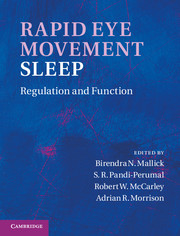Book contents
- Frontmatter
- Contents
- Contributors
- Preface
- Acknowledgments
- Organization
- Section I Historical context
- Section II General biology
- Section III Neuronal regulation
- Section IV Neuroanatomy and neurochemistry
- 19 Aminergic influences in the regulation of basic REM sleep processes
- 20 REM sleep regulation by cholinergic neurons: highlights from 1999 to 2009
- 21 GABAergic modulation of REM sleep
- 22 Glutamatergic regulation of REM sleep
- 23 The role of tuberomammillary nucleus histaminergic neurons, and of their receptors, in the regulation of sleep and waking
- 24 Hypocretinergic system: role in REM-sleep regulation
- 25 Neuropeptides and REM sleep
- 26 Adenosine and glycine in REM-sleep regulation
- 27 Changes in neurotransmitter levels in relation to REM sleep for its regulation
- 28 Pontine areas inhibiting REM sleep
- 29 Neuronal models of REM-sleep control: evolving concepts
- Section V Functional significance
- Section VI Disturbance in the REM sleep-generating mechanism
- Index
- Plate section
- References
19 - Aminergic influences in the regulation of basic REM sleep processes
from Section IV - Neuroanatomy and neurochemistry
Published online by Cambridge University Press: 07 September 2011
- Frontmatter
- Contents
- Contributors
- Preface
- Acknowledgments
- Organization
- Section I Historical context
- Section II General biology
- Section III Neuronal regulation
- Section IV Neuroanatomy and neurochemistry
- 19 Aminergic influences in the regulation of basic REM sleep processes
- 20 REM sleep regulation by cholinergic neurons: highlights from 1999 to 2009
- 21 GABAergic modulation of REM sleep
- 22 Glutamatergic regulation of REM sleep
- 23 The role of tuberomammillary nucleus histaminergic neurons, and of their receptors, in the regulation of sleep and waking
- 24 Hypocretinergic system: role in REM-sleep regulation
- 25 Neuropeptides and REM sleep
- 26 Adenosine and glycine in REM-sleep regulation
- 27 Changes in neurotransmitter levels in relation to REM sleep for its regulation
- 28 Pontine areas inhibiting REM sleep
- 29 Neuronal models of REM-sleep control: evolving concepts
- Section V Functional significance
- Section VI Disturbance in the REM sleep-generating mechanism
- Index
- Plate section
- References
Summary
Summary
Research into the influence of monoamines on REM sleep-generating processes began as early as 1964, 11 years after the discovery of REM sleep. Various studies have now established that noradrenergic neurons of the locus coeruleus must be silent for REM sleep to occur. However, the maintenance of a low level of noradrenaline is still necessary. This phenomenon is linked to the persistence of noradrenaline in the brain resulting from its diffuse release at the varicosity level and the absence of rapid noradrenaline elimination by reuptake and enzymatic destruction. The role of dopamine in the regulation of REM sleep was discovered more recently. The infusion of dopamine agonists into the REM sleep-inducing structure called the peri-locus coeruleus-α inhibits REM sleep. However, this effect can be blocked by the concurrent administration of dopamine antagonists, indicating a basic noradrenergic function. In the same way, lesions of the dopaminergic ventral periaqueductal gray matter increase REM sleep. Serotonergic neurons become silent during REM sleep, and serotonin, which is involved in processes that support waking, also has REM sleep-off influences. Finally, histamine appears to have indirect influences on REM sleep, as histaminergic neurons become silent as soon as sleep onset occurs. This monoamine acts in connection with orexin, a deficit of which favors REM sleep and narcolepsy. The narcoleptic attacks seen in knock-out mice lacking orexin can be prevented by antagonists of the H3 histamine autoreceptor.
- Type
- Chapter
- Information
- Rapid Eye Movement SleepRegulation and Function, pp. 183 - 193Publisher: Cambridge University PressPrint publication year: 2011



